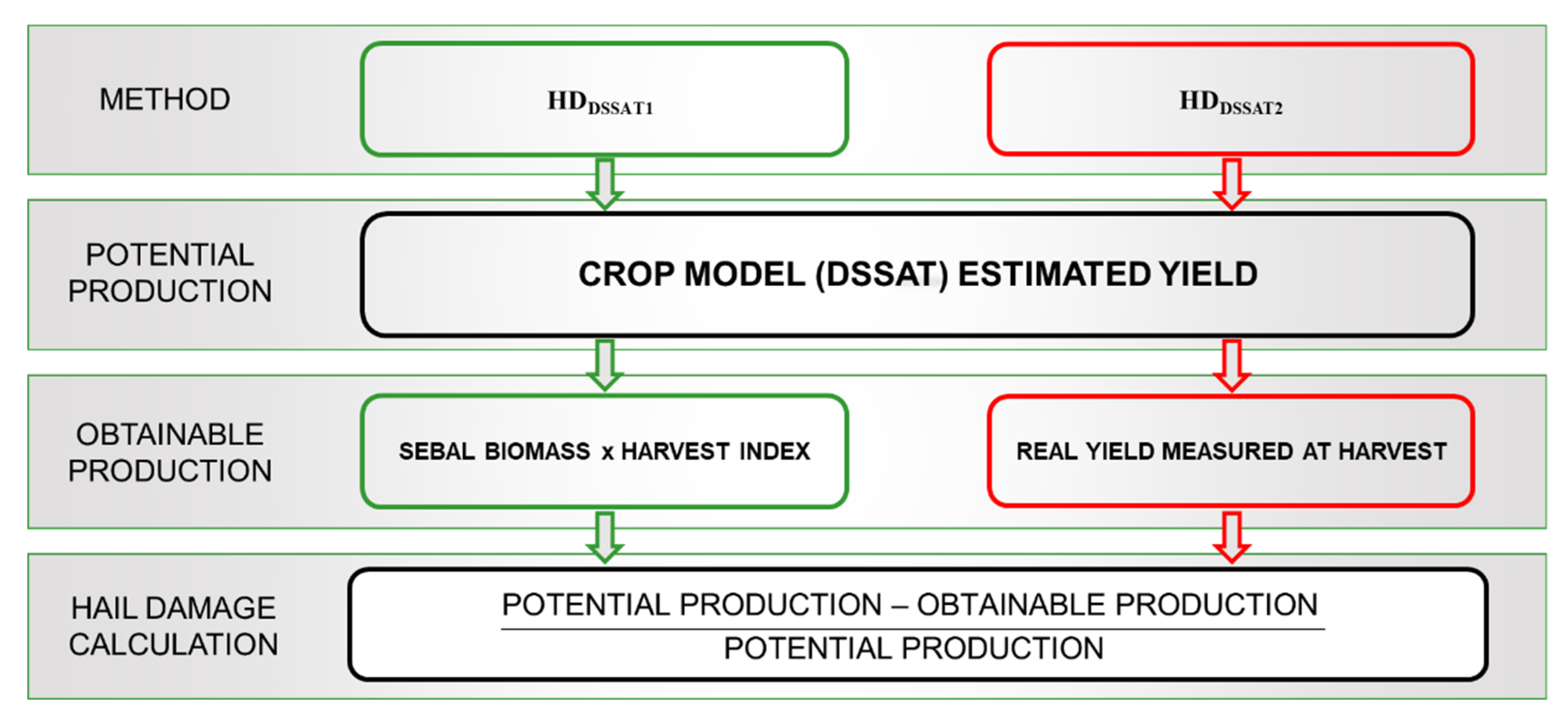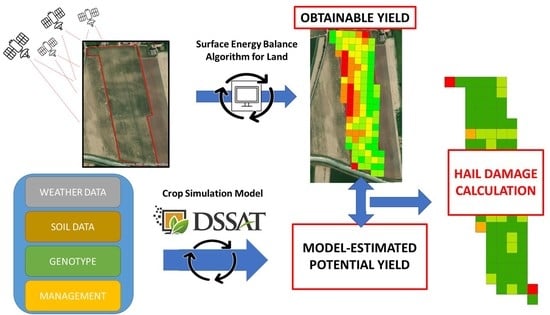Estimation of Hail Damage Using Crop Models and Remote Sensing
Abstract
:1. Introduction
2. Materials and Methods
2.1. Study Fields, Weather Data, and Soil Characterization
2.2. Soil Parameters, Plant Samples and Yield Maps
2.3. Field Survey for Hail Damage with the Insurance Company Method
2.4. Seasonal ET, Actual Biomass and Yield Estimates Using the Surface Energy Balance Algorithm for Land (SEBAL)
2.5. The Decision Support System for Agrotechnology Transfer (DSSAT) Crop Model
2.5.1. Cultivar Calibration and Potential Yield Estimates Using DSSAT
2.5.2. Estimates of Hail Damage with DSSAT and SEBAL-Based Methods
3. Results
3.1. SEBAL-Based vs. Measured Biomass and Yield Estimates
3.2. DSSAT Calibration and Potential Yield Estimates
3.3. Comparison of the Hail Damage Approaches
4. Discussion
5. Conclusions
Supplementary Materials
Author Contributions
Funding
Data Availability Statement
Conflicts of Interest
References
- Baldi, M.; Ciardini, V.; Dalu, J.D.; De Filippis, T.; Maracchi, G.; Dalu, G. Hail occurrence in Italy: Towards a national database and climatology. Atmos. Res. 2014, 138, 268–277. [Google Scholar] [CrossRef]
- Politeo, M. I Danni da Grandine Sulle Colture Agrarie del Veneto dal 1990 al 2004. Ph.D. Thesis, University of Padua, Padua, Italy, 2008. [Google Scholar]
- Kunz, M.; Blahak, U.; Handwerker, J.; Schmidberger, M.; Punge, H.J.; Mohr, S.; Fluck, E.; Bedka, K.M. The severe hailstorm in southwest Germany on 28 July 2013: Characteristics, impacts and meteorological conditions. Q. J. R. Meteorol. Soc. 2018, 144, 231–250. [Google Scholar] [CrossRef]
- Schuster, S.S.; Blong, R.J.; Speer, M.S. A hail climatology of the greater Sydney area and New South Wales, Australia. Int. J. Climatol. A J. R. Meteorol. Soc. 2005, 25, 1633–1650. [Google Scholar] [CrossRef]
- Changnon, S.A. Increasing major hail losses in the US. Clim. Chang. 2009, 96, 161–166. [Google Scholar] [CrossRef]
- Wang, E.; Bertis, B.L.; Jimmy, R.W.; Yu, Y. Simulation of hail effects on crop yield losses for corn-belt states in USA. Trans. Chin. Soc. Agric. Eng. 2012, 28, 177–185. [Google Scholar]
- Young, F.R.; Apan, A.; Chandler, O. Crop hail damage: Insurance loss assessment using remote sensing. In Proceedings of the Annual Conference of the Remote Sensing and Photogrammetry Society, Aberdeen, UK, 7–10 September 2004. [Google Scholar]
- Manzato, A. Hail in northeast Italy: Climatology and bivariate analysis with the sounding-derived indices. J. Appl. Meteorol. Climatol. 2012, 51, 449–467. [Google Scholar] [CrossRef]
- Punge, H.J.; Bedka, K.M.; Kunz, M.; Werner, A. A new physically based stochastic event catalog for hail in Europe. Nat. Hazards 2014, 73, 1625–1645. [Google Scholar] [CrossRef]
- Mohr, S.; Kunz, M.; Keuler, K. Development and application of a logistic model to estimate the past and future hail potential in Germany. J. Geophys. Res. Atmos. 2015, 120, 3939–3956. [Google Scholar] [CrossRef]
- Morgan, G.M., Jr. A general description of the hail problem in the Po Valley of northern Italy. J. Appl. Meteorol. Climatol. 1973, 12, 338–353. [Google Scholar] [CrossRef] [Green Version]
- Eldredge, J.C. The effect of injury in imitation of hail damage on the development of the maize plant. Iowa Agric. Home Econ. Exp. Stn. Res. Bull. 1935, 16, 1. [Google Scholar]
- Shapiro, C.A.; Peterson, T.A.; Flowerday, A.D. Yield Loss Due to Simulated Hail Damage on Corn: A Comparison of Actual and Predicted Values. Agron. J. 1986, 78, 585–589. [Google Scholar] [CrossRef]
- Vorst, J.J. Assessing Hail Damage to Corn; Iowa State University Extension: Ames, IA, USA, 1991. [Google Scholar]
- Towery, N.G.; Eyton, J.R.; Changnon, S.A., Jr.; Dailey, C.L. Remote Sensing of Crop Hail Damage; Illinois State Water Survey: Champaign, IL, USA, 1975. [Google Scholar]
- Erickson, B.J.; Johannsen, C.J.; Vorst, J.J.; Biehl, L.L. Using remote sensing to assess stand loss and defoliation in maize. Photogramm. Eng. Remote Sens. 2004, 70, 717–722. [Google Scholar] [CrossRef]
- Peters, A.J.; Griffin, S.C.; Viña, A.; Ji, L. Use of remotely sensed data for assessing crop hail damage. PE&RS, Photogramm. Eng. Remote Sens. 2000, 66, 1349–1355. [Google Scholar]
- Zhao, J.L.; Zhang, D.Y.; Luo, J.H.; Huang, S.L.; Dong, Y.Y.; Huang, W.J. Detection and mapping of hail damage to corn using domestic remotely sensed data in China. Aust. J. Crop Sci. 2012, 6, 101. [Google Scholar]
- Zhou, J.; Pavek, M.J.; Shelton, S.C.; Holden, Z.J.; Sankaran, S. Aerial multispectral imaging for crop hail damage assessment in potato. Comput. Electron. Agric. 2016, 127, 406–412. [Google Scholar] [CrossRef] [Green Version]
- De Leeuw, J.; Vrieling, A.; Shee, A.; Atzberger, C.; Hadgu, K.M.; Biradar, C.M.; Keah, H.; Turvey, C. The potential and uptake of remote sensing in insurance: A review. Remote Sens. 2014, 6, 10888–10912. [Google Scholar] [CrossRef] [Green Version]
- Ministero delle Politiche Agricole e Forestali. Metodi ufficiali di analisi chimica del suolo. Decreto Ministeriale 13 settembre 1999. In Supplemento Ordinario Alla Gazzetta Ufficiale n°248 del 21 Ottobre 1999; Ministero delle Politiche Agricole e Forestali: Rome, Italy, 1999. [Google Scholar]
- Vega, A.; Córdoba, M.; Castro-Franco, M.; Balzarini, M. Protocol for automating error removal from yield maps. Precis. Agric. 2019, 20, 1030–1044. [Google Scholar] [CrossRef]
- Nicoli, L. Procedure per la Stima dei Danni da Avversità Atmosferiche; Veneto Agricoltura: Legnaro, Italy, 2019. [Google Scholar]
- Bastiaanssen, W.G.; Menenti, M.; Feddes, R.A.; Holtslag, A.A.M. A remote sensing surface energy balance algorithm for land (SEBAL). 1. Formulation. J. Hydrol. 1998, 212, 198–212. [Google Scholar] [CrossRef]
- Vermote, E.F.; Tanré, D.; Deuze, J.L.; Herman, M.; Morcette, J.J. Second simulation of the satellite signal in the solar spectrum, 6S: An overview. IEEE Trans. Geosci. Remote Sens. 1997, 35, 675–686. [Google Scholar] [CrossRef] [Green Version]
- Grosso, C.; Manoli, G.; Martello, M.; Chemin, Y.H.; Pons, D.H.; Teatini, P.; Piccoli, I.; Morari, F. Mapping maize evapotranspiration at field scale using SEBAL: A comparison with the FAO method and soil-plant model simulations. Remote Sens. 2018, 10, 1452. [Google Scholar] [CrossRef] [Green Version]
- Gobbo, S.; Lo Presti, S.; Martello, M.; Panunzi, L.; Berti, A.; Morari, F. Integrating SEBAL with in-Field Crop Water Status Measurement for Precision Irrigation Applications—A Case Study. Remote Sens. 2019, 11, 2069. [Google Scholar] [CrossRef] [Green Version]
- Jones, C.A. CERES-Maize: A Simulation Model of Maize Growth and Development (No. 04; SB91. M2, J6.); Texas A&M University Press: College Station, TX, USA, 1986. [Google Scholar]
- Jones, J.W.; Hoogenboom, G.; Porter, C.H.; Boote, K.J.; Batchelor, W.D.; Hunt, L.A.; Wilkens, P.W.; Singh, U.; Gijsman, A.J.; Ritchie, J.T. The DSSAT cropping system model. Eur. J. Agron. 2003, 18, 235–265. [Google Scholar] [CrossRef]
- Hoogenboom, G.; Jones, J.; Wilkens, P.; Porter, C.; Boote, K.; Hunt, L.D.; Singh, U.; Lizaso, J.I.; White, J.M.; Uryasev, O.; et al. Decision Support System for Agrotechnology Transfer (DSSAT) Version 4.5; Honolulu University: Honolulu, HI, USA, 2010; Volume 1. [Google Scholar]
- Zwart, S.J.; Bastiaanssen, W.G. SEBAL for detecting spatial variation of water productivity and scope for improvement in eight irrigated wheat systems. Agric. Water Manag. 2007, 89, 287–296. [Google Scholar] [CrossRef]
- Scudiero, E.; Teatini, P.; Corwin, D.L.; Ferro, N.D.; Simonetti, G.; Morari, F. Spatiotemporal response of maize yield to edaphic and meteorological conditions in a saline farmland. Agron. J. 2014, 106, 2163–2174. [Google Scholar] [CrossRef] [Green Version]







| Field ID | FAO Class | Planting Date | Fertilization | Irrigation * | Harvest | |
|---|---|---|---|---|---|---|
| Field 1; D | 500 | 03/29/19 | 270 N; 100 P2O5 | 3; 450 | 09/04/19 | |
| Field 2; D | 500 | 03/28/19 | 170 N; 125 P2O5 | N/A | 08/28/19 | |
| Field 3; D | 500 | 03/27/19 | 300 N; 184 P2O5 | 2; 500 | 09/02/19 | |
| Field 4; D | 300 | 03/28/19 | 230 N; 185 P2O5 | N/A | 08/18/19 | |
| Field 5; D | 300 | 03/28/19 | 230 N; 185 P2O5 | N/A | 08/18/19 | |
| Field 6; ND | 500 | 03/27/19 | 295 N; 105 P2O5 | 1; 500 | 09/19/19 | |
| Field 7; ND | 500 | 03/28/19 | 230 N; 80 P2O5; 80 K2O | 2; 450 | 09/14/19 | |
| Field 8; ND | 300 | 03/28/19 | 265 N; 30 P2O5 | 2; 500 | 08/20/19 | |
| Field ID | Measured Yld [t DM ha−1] | SEBAL HIreal [t DM ha−1] | SEBAL HI0.4 [t DM ha−1] | SEBAL HI0.45 [t DM ha−1] | SEBAL HI0.5 [t DM ha−1] |
|---|---|---|---|---|---|
| Field 1, D | 6.01 | 7.81 (30.0) | 5.79 (3.7) | 6.51 (8.3) | 7.23 (20.3) |
| Field 2, D | 6.33 | 6.25 (1.3) | 4.72 (25.5) | 5.31 (16.2) | 5.90 (6.9) |
| Field 3, D | 9.17 | 9.31 (1.5) | 6.01 (34.5) | 6.76 (26.3) | 7.51 (18.1) |
| Field 4, D | 8.36 | 4.63 (44.6) | 3.86 (53.9) | 4.34 (48.1) | 4.82 (42.3) |
| Field 5, D | 6.28 | 6.51 (3.7) | 6.51 (3.7) | 7.32 (16.6) | 8.14 (29.6) |
| Field 6, ND | 9.16 | 10.80 (17.9) | 8.47 (7.5) | 9.53 (4.0) | 10.59 (15.6) |
| Field 7, ND | 11.90 | 11.46 (3.7) | 7.44 (37.5) | 8.37 (29.7) | 9.30 (21.8) |
| Field 8, ND | 10.70 | NC | NC | NC | NC |
| Field | HDInsurance | HDDSSAT1 | HDDSSAT2 | HDDSSAT1_0.4 | HDDSSAT1_0.45 | HDDSSAT1_0.5 |
|---|---|---|---|---|---|---|
| [%] | [%] | [%] | [%] | [%] | [%] | |
| FIELD 1 | 22.8 | 19.8 | 38.3 | 40.6 | 33.2 | 25.7 |
| FIELD 2 | 20.2 | 15.3 | 14.2 | 36.1 | 28.1 | 20.1 |
| FIELD 3 | 30.8 | 34.6 | 35.6 | 57.8 | 52.5 | 47.3 |
| FIELD 4 | 13.0 | 51.1 | 11.7 | 59.2 | 54.2 | 49.1 |
| FIELD 5 | 9.9 | 9.5 | 12.7 | 9.5 | 0.0 | 0.0 |
| AVERAGE | 19.3 | 26.1 | 22.5 | 40.7 | 33.6 | 28.4 |
Publisher’s Note: MDPI stays neutral with regard to jurisdictional claims in published maps and institutional affiliations. |
© 2021 by the authors. Licensee MDPI, Basel, Switzerland. This article is an open access article distributed under the terms and conditions of the Creative Commons Attribution (CC BY) license (https://creativecommons.org/licenses/by/4.0/).
Share and Cite
Gobbo, S.; Ghiraldini, A.; Dramis, A.; Dal Ferro, N.; Morari, F. Estimation of Hail Damage Using Crop Models and Remote Sensing. Remote Sens. 2021, 13, 2655. https://doi.org/10.3390/rs13142655
Gobbo S, Ghiraldini A, Dramis A, Dal Ferro N, Morari F. Estimation of Hail Damage Using Crop Models and Remote Sensing. Remote Sensing. 2021; 13(14):2655. https://doi.org/10.3390/rs13142655
Chicago/Turabian StyleGobbo, Stefano, Alessandro Ghiraldini, Andrea Dramis, Nicola Dal Ferro, and Francesco Morari. 2021. "Estimation of Hail Damage Using Crop Models and Remote Sensing" Remote Sensing 13, no. 14: 2655. https://doi.org/10.3390/rs13142655
APA StyleGobbo, S., Ghiraldini, A., Dramis, A., Dal Ferro, N., & Morari, F. (2021). Estimation of Hail Damage Using Crop Models and Remote Sensing. Remote Sensing, 13(14), 2655. https://doi.org/10.3390/rs13142655







